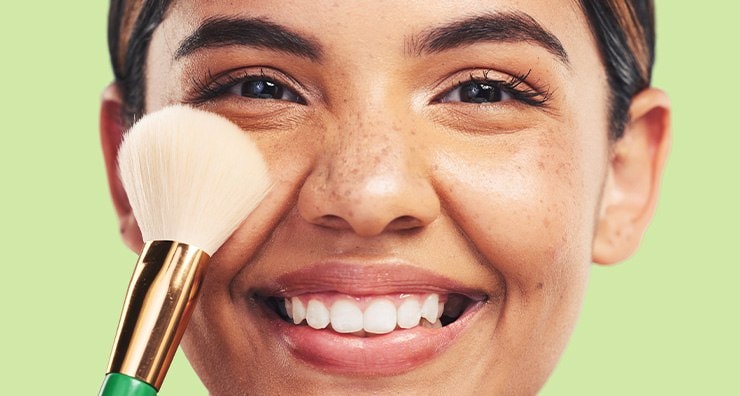
About the Author
Jill is a content writer for LovelySkin. She loves reading up on the latest beauty trends, going to concerts with her husband and baking with her three kids.
Other Posts by JillWelcome to LovelySkin.com.

Most savvy consumers of skincare products are used to reading the back of the label to evaluate the ingredients, such as hyaluronic acid and niacinamide. It’s become increasingly important to look for the presence of per- and polyfluoroalkyl substances (PFAS), informally known as forever chemicals, because they resist breaking down and can accumulate in the environment as well as human and animal bodies over time.
“PFAS are synthetic chemicals that may be found in everyday products like non-stick pots and pans, furniture, food packaging, and much more. They are sometimes added to makeup, skin and hair care to condition and smooth, help a product resist water and enhance a product’s texture and longevity in the packaging,” explains board-certified dermatologist, Mohs surgeon and cosmetic surgeon Dr. Joel Schlessinger. “While we wish these weren’t in any products, up until now, this problem hasn’t been fully recognized and luckily, all manufacturers are now working to get them out of formulations. It is a little later than we would wish, but better to have it done fully as these chemicals are potentially quite harmful and should be avoided if possible.”
In 2014, the PFAS known as PFOA (perfluorooctanoic acid) was identified as a possible human carcinogen and in 2023 was upgraded to a human carcinogen. The CDC also has linked increases in exposure to certain PFAS with an elevated risk of health conditions like increased cholesterol levels, changes in liver enzymes, lower antibody response to certain vaccines, elevated blood pressure during pregnancy and more.
While there have been few studies on PFAS in cosmetics like makeup, skin care and hair care products, more people than ever are trying to rid their daily regimens of unnecessary chemicals as health concerns persist. We’re breaking down what you need to know about PFAS in cosmetics, skin care and hair care by discussing:
The FDA defines PFAS as a “diverse group of human-made chemicals used in a wide range of consumer and industrial products.” These chemicals have been around since the 1940s and help a product resist water, heat, oil and stains. Within a household, you may recognize them as the chemicals that keep your food from sticking to pots and pans, helping your furniture and carpet fight water and stains and helping the wrapper on fast food or pizza boxes resist soaking in grease.
While more studies are needed to understand their exact mechanisms and how much exposure is too much exposure, PFAS can enter the body through contaminated drinking water or food, inhalation of air containing PFAS or direct ingestion of the chemical by swallowing residue containing PFAS. While dietary ingestion is the primary route of exposure, a 2020 study showed that certain PFAS molecules can also be absorbed through the skin.
Dr. Daniel Schlessinger, board-certified dermatologist as well as Mohs surgeon and cosmetic surgeon gives some background on the chemical makeup of PFAS, “All PFAS chemicals contain a chain of carbon atoms bonded to fluorine atoms. The carbon-fluorine bond is one of the strongest in organic chemistry, and that’s the reason PFAS chemicals resist breaking down and can exist forever in our environment. This creates a problem of not only worrying about applying PFAS-containing products to our skin or hair but that they also enter the waterways and environment permanently when we wash them off.”
While there are thousands of ingredients that can be categorized as PFAS, the US Food and Drug Administration (FDA) reports that a few common PFAS in cosmetics include, but aren’t limited to:
In many cases, cosmetic products that are marketed as “long wear” or “waterproof” can contain PFAS, so waterproof mascaras and wear-resistant liquid lipsticks, nail polishes and powders might be culprits. In products like moisturizers, foundations, concealers, shaving creams and sunscreens, certain PFAS may be included to help the cream or lotion spread smoothly or to impart a “sheen” to the skin.
Some manufacturers use PFAS intentionally in their cosmetic formulas, but in other cases, they may not be on the ingredient list because they end up in the formula unintentionally through raw materials or from other ingredients that break down over time. PFAS exist in our environment so pervasively that in some cases, there can be cross-contamination during manufacturing processes.
The only study that has evaluated the risk of PFAS in cosmetics evaluated five specific types of PFAS unintentionally included in body lotion, foundation or CC cream and concealer. The FDA reports that the researchers determined the products themselves are unlikely to pose a risk for consumers, but more studies are needed.
In response to consumer demands for clean formulas and ingredient transparency, many beauty brands have actively been lobbying for increased regulation in cosmetic formulations. In 2022, the Modernization of Cosmetics Regulation Act (MoCRA) was signed into legislation, granting the FDA more control over regulations in the beauty industry. As part of the law, the FDA now has the power to recall cosmetic products, as well as require facility registrations for cosmetic product manufacturing, adverse event reporting and improved labeling on cosmetic products. The legislation includes additional oversight of the use of PFAS in cosmetics and other personal care products.
Many states have also enacted their own laws in an effort to regulate the use of PFAS in cosmetics, including:
Transparency in your skin, hair and makeup products is important and concerns over the potential health effects of PFAS and other chemicals have prompted many to take a second look at what exactly is in the formulas we use daily. Dr. Joel Schlessinger says, “As for PFAS, there is some question about their risk among researchers, but we feel it is a good thing to be rid of it in our products,” says Dr. Schlessinger. You’ll be happy to know that our team at LovelySkin has checked in with the brands we offer and have insisted they work as quickly as possible to get any products with PFAS out of their lineups and reformulate with better ingredients. As of now, they are working to reformulate ahead of the legislation deadline.
If you want to avoid PFAS, you can look for brands that specifically label their products as PFAS-free or adjust your regimen by avoiding anything with PFAS. We will be making sure our offerings don’t have them as well. However, be prepared for your products to potentially work differently than you’re used to. Dr. Schlesinger adds, “The problem is that PFAS is also one of the best foaming agents since sodium lauryl sulfate, so those who enjoy a foaming cleanser may have a lesser foaming experience. The good news is that some alternatives can foam fairly well.”
If you want to check your current collection of cosmetics and personal care products for PFAS, Dr. Daniel Schlessinger has this expert tip, “If you are uncertain about whether a product might contain PFAS, a good rule of thumb is to look for the phrase “fluoro” in the ingredient name. While not the case every time, it shows the formula might contain fluorine, which is an indicator of PFAS.”
You can learn more about clean beauty products, including what you need to know about organic beauty, by reading the LovelySkin blog.
How to get your significant other on a b...
How to choose the right sunscreen with I...
Follow us on social networks and be one of the first to learn about sales, giveaways, and free samples
| Mon - Fri | 9 - 5 p.m. CT |
|---|---|
| Sat (chat only) | 9 - 3 p.m. CT |
| Sun / Holidays | Closed |
| Call or Text: | 402-697-1100 |
|---|